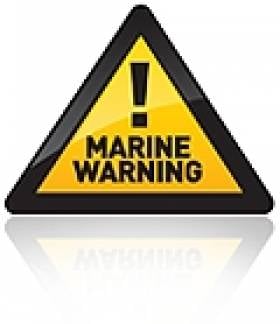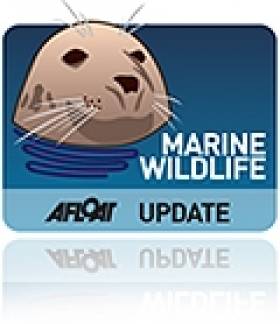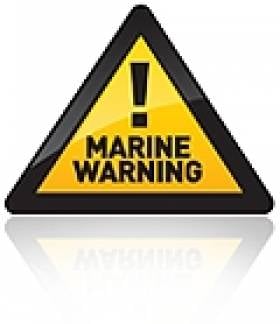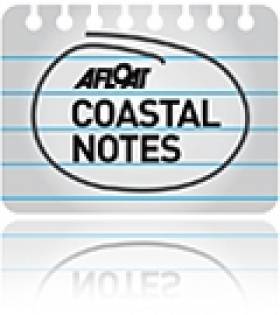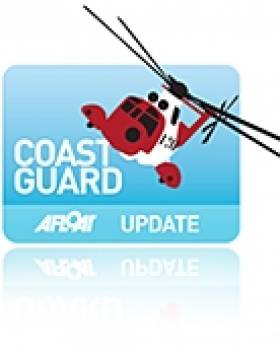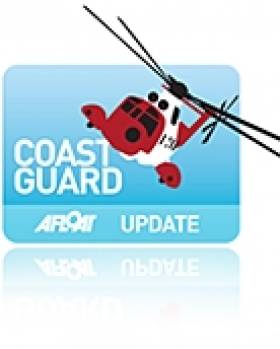Displaying items by tag: Clare
#MarineNotice - Marine Notice No 15 of 2013 from the Department of Transport, Tourism and Sport (DTTAS) advises mariners that a hydrographic and geophysical survey operation is being undertaken by INFOMAR for the Sustainable Energy Authority of Ireland till 25 April.
The RV Celtic Voyager (Call sign EIQN) is carrying out the survey operations within an area bounded by co-ordinates included in the notice, available as a PDF to read or download HERE.
The vessel is towing a magnetometer sensor with a single cable of up to 100m in length. It is also displaying appropriate lights and markers, and will listen in on VHF Channel 16 throughout the project.
Meanwhile, Marine Notice No 16 of 2013 advises that Shell E&P Ireland is deploying a Waverider buoy off northwest Co Mayo to help predict sea conditions for the laying of an offshore umbilical to the Corrib Gas Field later this year.
The buoy is yellow in colour and will flash yellow five times every 20 seconds. The notice includes an image of what the buoy looks like in the water, as well as the co-ordinates of its placement.
All vessels are requested to give the wave buoy a wide berth.
Dolphin Trio At Home Near Famous Watering Hole
#MarineWildlife - Three bottlenose dolphins have made a new home close to a famous tourist watering hole in Co Clare.
According to the Irish Independent, the trio have taken up residence next to Durty Nellys pub in the Ratty River, which flows past Bunratty Castle into the Shannon Estuary.
The Irish Whale and Dolphin Group (IWDG), which has been tracking the group, believes they originated from a larger group populating the estuary.
As the IWDG's Simon Berrow explains, such dolphins are known to forage for food in rivers that feed into the estuary, and will return to the main catchment on their own.
While the risk of stranding in the shallower waters of rivers is unlikely, there is growing concern that the dolphins have been in the area for longer than expected.
"We can't rule out the possibility that their acoustic abilities may be impaired by the series of bridges and concrete pillars that span one of the bridges, and that they may be finding it difficult to navigate as a result of an 'acoustic trap'," says Berrow.
The IWDG says it is in discussion with the National Parks and Wildlife Service as to what options are available to step in to shepherd the trio back to the Shannon Estuary if necessary.
Marine Notice: Clare Coast Hydrographic Survey
#MarineNotice - The latest Marine Notice from the Department of Transport, Tourism and Sport advises of a hydrographic and geophysical survey operation being presently undertaken off the Clare coast till Tuesday 19 March.
The RV Celtic Voyager (Call sign EIQN) is carrying out these survey operations for INFOMAR on behalf of the Sustainable Energy Authority of Ireland (SEAI).
The vessel will be towing a magnetometer sensor with a single cable of up to 100m in length. The Celtic Voyager will be listening on VHF Channel 16 throughout the project and will display appropriate lights and markers.
Details of co-ordinates for the survey area are included in Marine Notice No 10 of 2013, a PDF of which is available to read or download HERE.
'Whale Vomit' Could Be Worth Thousands To Clare Surfing Pair
#Ambergris - The idea of 'whale vomit' is surely off-putting to most, but to high-end perfume companies it's worth more than gold - much to the delight of two Irish surfers who believe they've found a lump of the stuff.
The Irish Daily Star, via IrishCentral, reports that Alan Davey and Brian Miller discovered the turnip-sized lump of what appears to be whale excrement on the beach at the popular surfing haunt of Lahinch on the Co Clare coast.
And if it turns out to be the product of a sperm whale, it might well contain the valuable substance known as ambergris - produced in their digestive tract, and traditionally used as a key ingredient in perfumes - and could fetch the pair a cool €50,000.
A similar find on a beach at Morecambe in Lancashire last month could be worth as much as €115,000 to its finder, according to The Guardian.
Doolin Pier Gets Green Light from An Bord Pleanala
#doolinpier – Clare County Council today (Wednesday, 6 March 2013) welcomed the announcement by An Bord Pleanala of its decision to give the go ahead for the construction of a new pier in the North Clare coastal village of Doolin.
The Council said it has reviewed the terms of the Bord's decision and will be meeting the project consultants with a view to commencing the tendering process in the near future.
Reacting to today's announcement, Mayor of Clare Councillor Pat Daly said: "I am delighted that the green light has finally been given for this vitally important piece of infrastructure following years of open debate and discussion on what the best way forward should be. I wish to compliment Clare County Council and its officials for facilitating the process and ensuring that everyone's voice was heard. The Pier will bring increasing numbers of people to County Clare considering access to the Aran Islands from the County will be greatly enhanced once the project is completed."
Tom Coughlan, Clare County Manager said An Bord Pleanala's decision today was "the result of a comprehensive proposal submitted by the Council and extensive consultation with users of the pier as well as the local community."
He continued: "Clare County Council has invested considerable time and resources into ensuring that the Doolin Pier project is one that benefits all users of the existing pier. Once completed, this project will have significant, positive economic and social consequences for the people of North Clare and the wider region. For example, the construction phase of the project will create jobs as will the increase in business that will arise as a result of the Pier's completion."
Tom Tiernan, Senior Engineer and Doolin Pier Project Manager commented: "I wish to pay tribute to the Council Consultants, led by Malachy Walsh and Partners, who have guided the project from its inception through the various stages of planning, including the preparation of the Environmental Impact Statement (EIS) which ultimately facilitated An Bord Pleanala's decision today."
"He added: "The provision of this new pier will have a hugely positive impact on the operations of Ferry operators, fishermen and the local search and rescue unit, who have been finding it increasingly difficult to launch their boats at low water levels."
"The next stage of the Pier project is construction. We will shortly be meeting with the project consultants with a view to getting a tender process underway as soon as possible. We anticipate that the project will be completed during early 2015," concluded Mr. Tiernan.
Minister Approves New Coastguard Station for Doolin
#Coastguard - Minister for Transport Leo Varadkar has given approval for the construction of a new volunteer coastguard station in Doolin, Co Clare.
The €1.8-million project, to be overseen by the Office of Public Works, will be tendered within a matter of weeks, with construction expected to start in early April.
The Doolin unit of the Irish Coast Guard is one of the busiest in the country and operates a cliff rescue team, a boat unit and shoreline search team. The 24-member team is supported by seven additional volunteers located on nearby Inisheer.
The unit was featured on the recent RTÉ programme Ireland’s Search & Rescue conducting cliff and boat rescue operations.
Volunteers currently operate out of a temporary premises and a nearby rented farm shed. The new station will provide a garage area for the storage of boats, cliff rescue, personal equipment and transport as well as changing facilities and an operations room.
Minister Varadkar said: "I am delighted to be able to confirm funding for the new Doolin coastguard station. I am very conscious of the demands placed on the unit and I am keen to provide them with a base to so they can continue to serve their community and the many visitors to the Doolin area, including the Cliffs of Moher.
“In both 2012 and 2011 the Doolin unit responded to over 40 call-outs each year. This is a long-term investment in the Doolin area and acknowledges the efforts and service that the volunteers continue to provide.”
The Doolin coastguard unit is currently awaiting an update on long-delayed plans to redevelop the pier facilities at Doolin, which rescuers argue are "regularly over-congested" in peak tourist periods - though the current plans face opposition from local surfers who fear a negative impact on the renowned Crab Island surf break in the area.
Two Dead In Separate Incidents At Sea On Thursday
#Coastguard - The Irish Times reports on the death of a local fisherman off the Waterford coast on Thursday morning in an incident that prompted a major coastguard and lifeboat search and rescue operation - six years to the day after the tragic sinking of Dunmore East trawler the Pere Charles.
The Irish Coast Guard's Rescue 117 helicopter was dispatched to before 8am along with the RNLI lifeboats from Dunmore East and Tramore to the scene off Brownstown Head after a 16-foot fishing boat capsized, throwing its two-man crew into the water.
James Tate reached the shore unaided after some two hours in the water to raise the alarm. He was later treated for shock and hypothermia.
His friend Johnny Flynn - a former member of the Dunmore East lifeboat crew, according to the Irish Independent - was found unconscious in the water by the coastguard helicopter before 8.30am, but efforts to resuscitate him were unsuccessful.
The men's boat has been recovered, and a spokesperson for the Marine Casualty Investigation Board confirmed that a full investigation and inquest into Flynn's death would take place.
The incident came just two days after four fishermen were rescued from their boat off Hook Head in Co Waterford.
Elsewhere, it's reported that a Spanish fisherman died after sustaining head injuries on a trawler off Loop Head in Co Clare on Thursday morning.
The Irish Times has more on both stories HERE.
Surfers, Islanders Clash at Doolin Pier Hearing
#COASTAL NOTES - Clare surfers say they have no confidence that development plans for Doolin Pier will not have a negative impact on the Crab Island surf break.
The Irish Examiner reports on an oral hearing on the project held by An Bord Pleanála in Ennistymon on Wednesday morning at which representatives of the Irish Surfing Association and the West Cost Surf Club expressed their fears of losing "the jewel in the crown" of Irish surfing.
As previously reported on Afloat.ie, local surfers have been at loggerheads with Clare County Council over long-delayed plans to redevelop the pier facilities at Doolin, which currently serves more than 70,000 passengers between the Clare coast and the Aran Islands.
At present the pier cannot be accessed at low tide, and foul weather cost the ferry route to 40 days's business last year, the meeting heard.
Island co-op Comhar Caomhán Inis Oírr is among the groups supporting the €8 million development plans, arguing that the islands would be "under threat" if the project does not proceed.
Marine Notice: Rock Placements Off Co Dublin & Buoy Deployments Off West Cast
#MARINE WARNING - The latest Marine Notices from the Department of Transport, Tourism and Sport (DTTAS) advise mariners to keep a look-out for rock placement off north Co Dublin and buoy placements off Co Mayo and Co Clare.
Operations were due to commence on Saturday 8 September at North Beach in Rush, Co Dublin for the placement of rocks offshore and in the Irish Sea for a period of 10-12 days weather permitting.
The works are being undertaken by DPFPV Tideway Rollingstone (call sign PHYR) and DPFPV Stornes (call sign PCKX) at various locations detailed in Marine Notice No 49 of 2012, a PDF of which is available to read or download HERE.
These vessels are operating on a 24-hour basis and will display appropriate days shapes and lights. They are also transmitting an AIS signal and will keep a listening watch on VHF Channel 16 for the duration of the works, which involve the deployment of survey ROVs and fall pipe that will restrict the vessels' movements. All mariners are instructed to give a wide berth.
Meanwhile off the west coast, ESB International has deployed two Waveroder buoys as positions near Achill Island in Co Mayo and Doonbeg in Co Clare.
The Achill buoy will be operational for a minumum of three months from now, while the Killard buoy will be operational for a minimum of 10 months having been recently relocated. Both are spherical and yellow in colour. All vessels are requested to give the buoys a wide berth.
Full details of their positions are included in Marine Notice No 50 of 2012, a PDF of which is available to read or download HERE.
Double Tragedy for Beara Peninsula as Retired Teacher Drowns
#NEWS UPDATE - The Irish Times reports that the body of a retired schoolteacher was recovered from the sea off Castletownbere in West Cork on Friday in the second tragedy the area has seen this week.
Sixty-six-year-old Pearse Lyne drowned after his fishing boat capsized in poor weather off the Beara Peninsula.
A search operation was launched around 1.30pm after a cliffwalker spotted the upturned vessel near the Dzogchen Buddhist retreat, and the body of the father of four and former national school principal was discovered some 90 minutes later in the water near Pulleen harbour.
The sad incident occurred just says after farmer and poet John O'Leary drowned off Cod's Head when the Enterprise sailing dinghy he was sailing with his teenage son Christopher capsized.
As previously reported on Afloat.ie, Minister for the Marine Simon Coveney paid tribute to O'Leary as well as Quilty fishermen Michael Galvin and Noel Dickinson, who drowned earlier this week off the Clare coast.
Meanwhile, in Dongeal a diver was rescued after getting into difficulty in Lough Salt on Thursday evening, according to the Donegal Democrat.
The Donegal native was one of two divers in the lough at the time, and is believed to have experienced buoyancy issues while some 50m below the surface.
He was taken to Letterkenny General Hospital and later transferred to Craigavon for treatment for decompression sickness. The man is now recovering.
His diving partner, an Italian national living in Ireland, made it to shore unharmed.



























